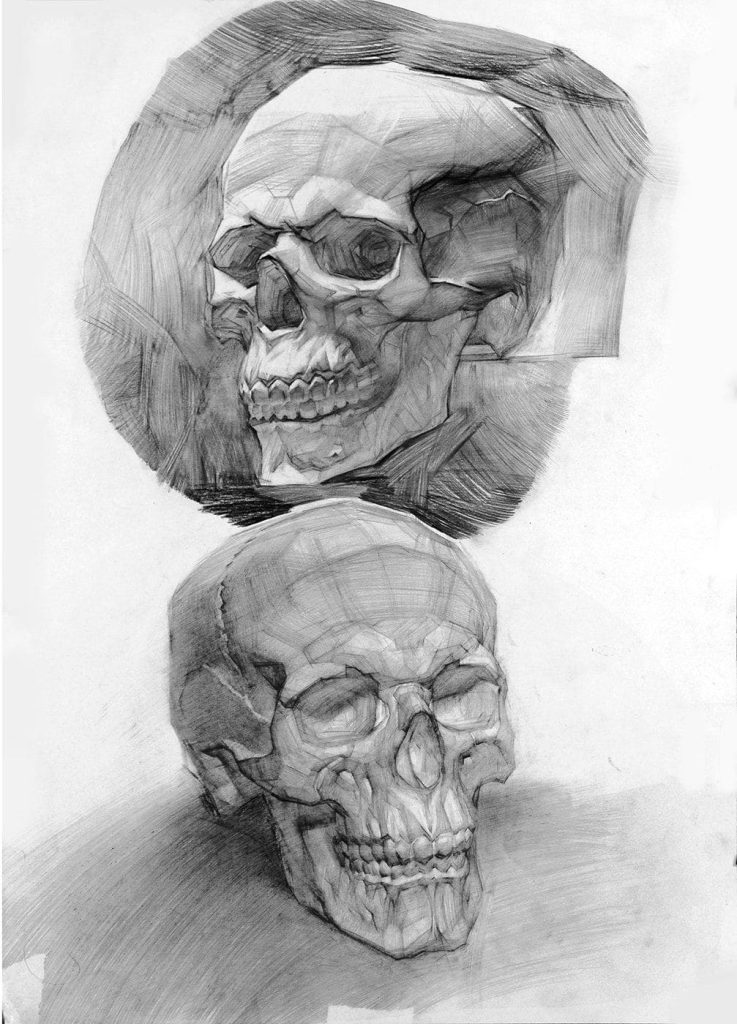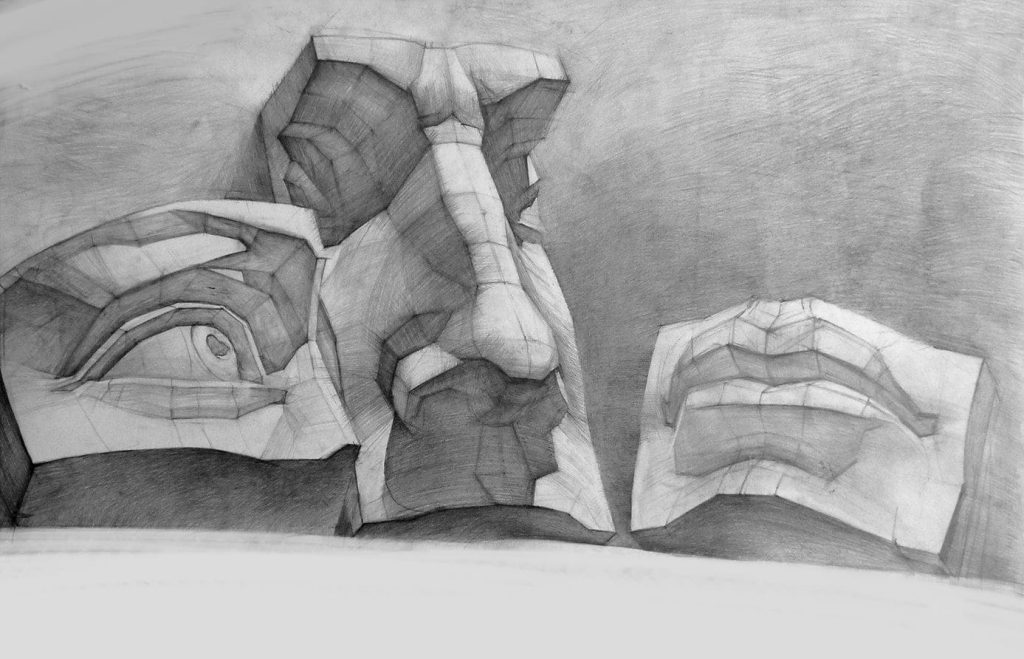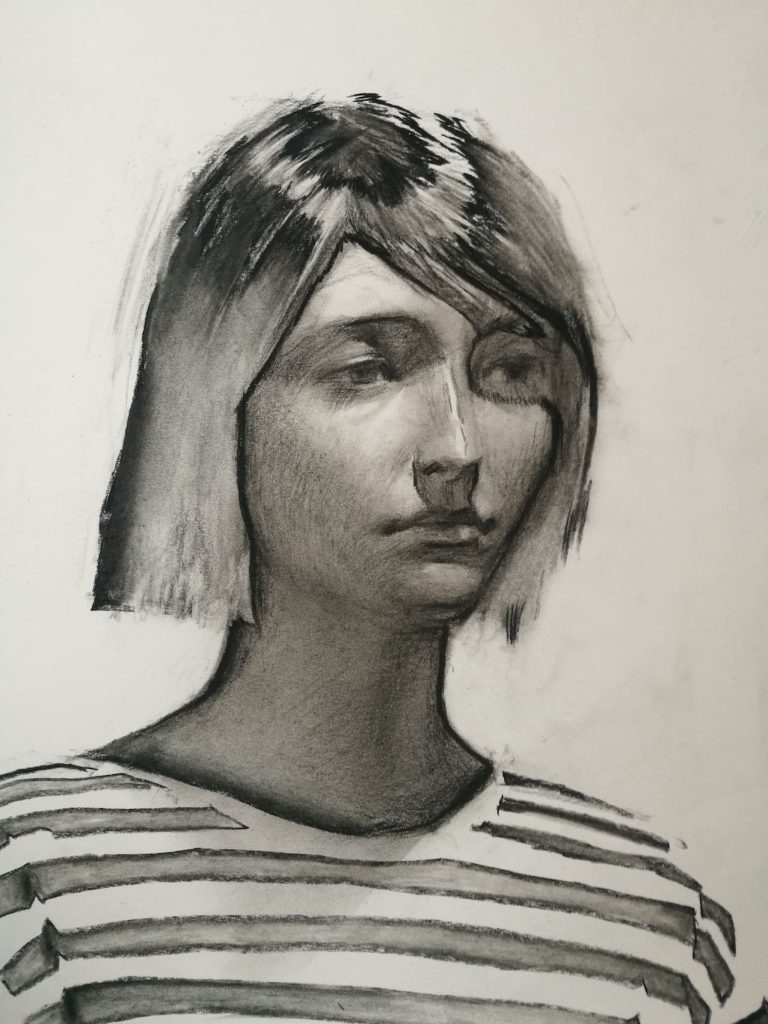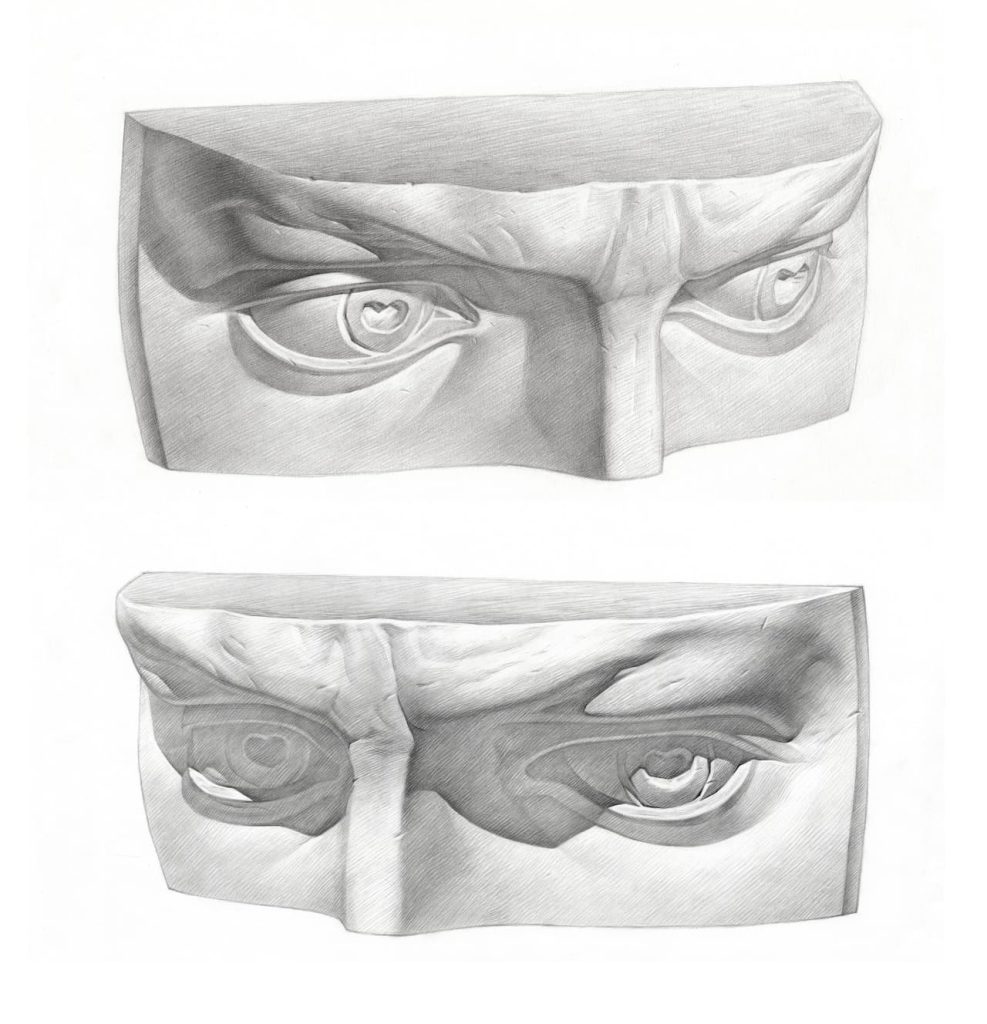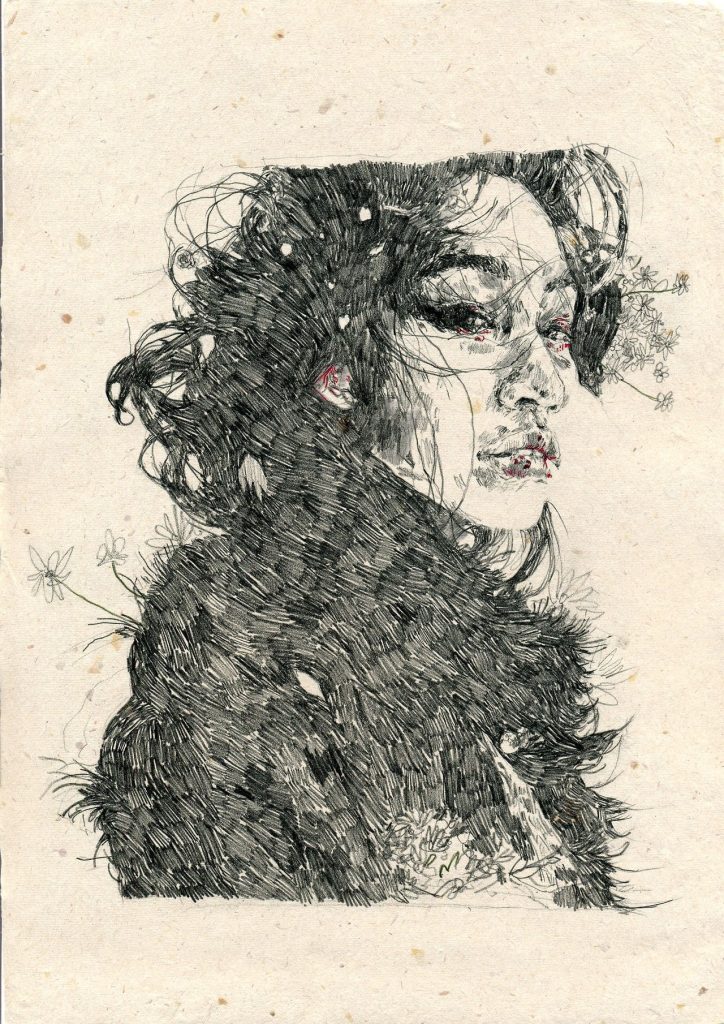Academic drawing is a visual art form that helps to convey the volume and texture of a subject using line, stroke, and light shading. It is the oldest form of fine art and a subspecies of graphics.
In the course of work on academic drawing, you learn to depict three-dimensional figures, to determine for them the ideal place in the composition, learn the laws of perspective, pump up the skills of arrangement of objects on a sheet of paper, the ability to correctly reflect the proportions, to create light and shadow modeling of the form and to convey the texture of objects.
Academic drawing utilizes linear-constructive and tonal methods of drawing.
Linear-constructive drawing
The linear-constructive method emphasizes the linear contours of an object to create a clear structure and shape of the object. Line is good to work with at the stage of finding proportion, layout in the sheet and building the form. The linear-constructive method is also used for human anatomical drawings and sketches from life.
Tone pattern
The tonal approach method of drawing focuses on conveying tones and halftones to create volume and depth in a drawing. He uses light shadows to emphasize the volume of objects.
The tonal method is widely used in creating realistic still lifes, portraits, landscapes and other images. It allows the artist to convey light and shadow, making the drawing more three-dimensional.
Both methods can be used together to create more complex and interesting artwork, and the choice between the two depends on the artist’s goals and the nature of the subject being depicted.
The importance of academic drawing
Academic drawing has many meanings and applications. First, it provides a foundation for the development of artistic skills and craftsmanship. It helps artists develop the eye for accurate rendering of form and proportion, understand light shading and perspective.
Academic drawing allows artists to improve their technique and style and develop their individuality in art.
In addition, academic drawing is often used for educational purposes, including the study of anatomy, architecture, and design. It develops imagination, observation and vision, and helps to build objects competently, to convey their volume, light and shadow and texture characteristics.
Academic drawing can be used as a preliminary stage before creating full works of illustration, painting or printmaking. Using it, artists can experiment with foreshortening, composition and texture, and develop ideas for future works.
Academic Drawing is useful for painters, designers, architects, sculptors and anyone interested in the visual arts.
History of academic drawing

The history of drawing dates back to ancient times, when people began to depict hunting scenes, human and animal figures on cave walls to convey important information to each other, but the history of academic drawing is linked to the development of higher education in the fine arts. This style and method of teaching drawing became widespread in the academies and art schools of Europe, especially in the seventeenth and nineteenth centuries.
- Early period: the emergence of academic drawing is associated with the ideas of classicism and the influence of the Italian Renaissance. During the Renaissance in Italy in the 15th century, academies and art schools began to form where drawing was seen as an important element of learning.
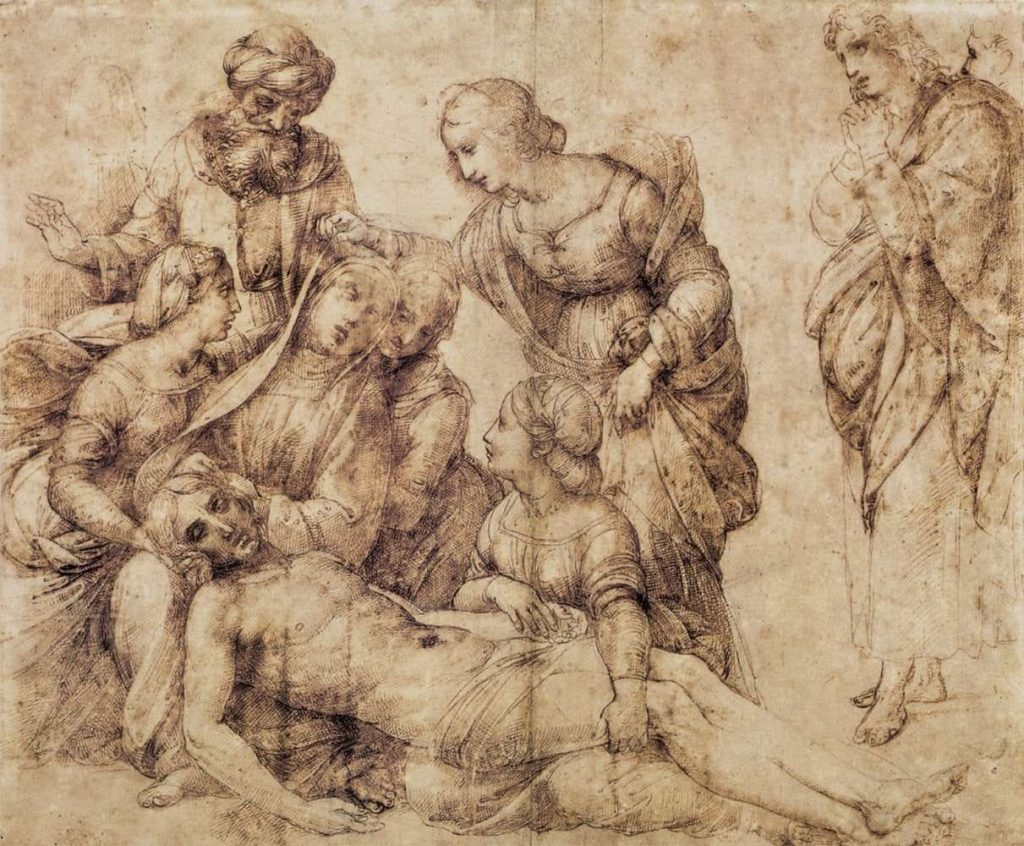
- Baroque and Rococo: In the 17th and 18th centuries, academic drawing became more complex and refined under the influence of Baroque and Rococo. Artists strove for perfection in drawing, learning to depict anatomical details and express emotions.
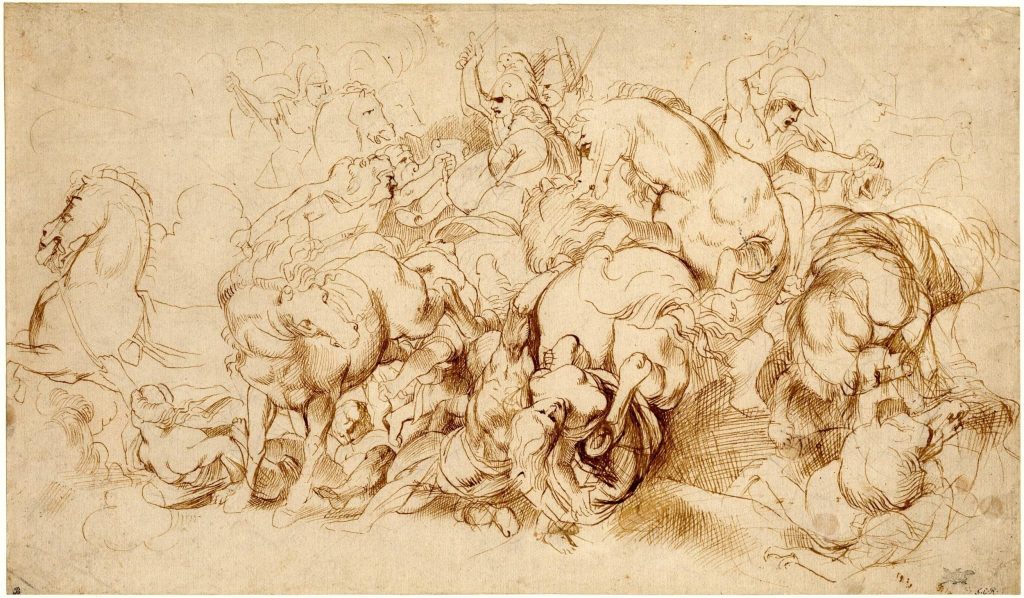
- Académie royale de peinture et de sculpture (Academy of Fine Arts): in the 17th century, the Académie royale de peinture et de sculpture (Academy of Fine Arts) was founded in France and became an important center of academic art. The Academy defined standards and rules in the arts, including requirements for drawing.
- Classicism: in the late eighteenth century and into the nineteenth century, academic drawing became a reflection of classicism. The artists strove for perfection of form and composition, following the ideals of ancient Greek art.
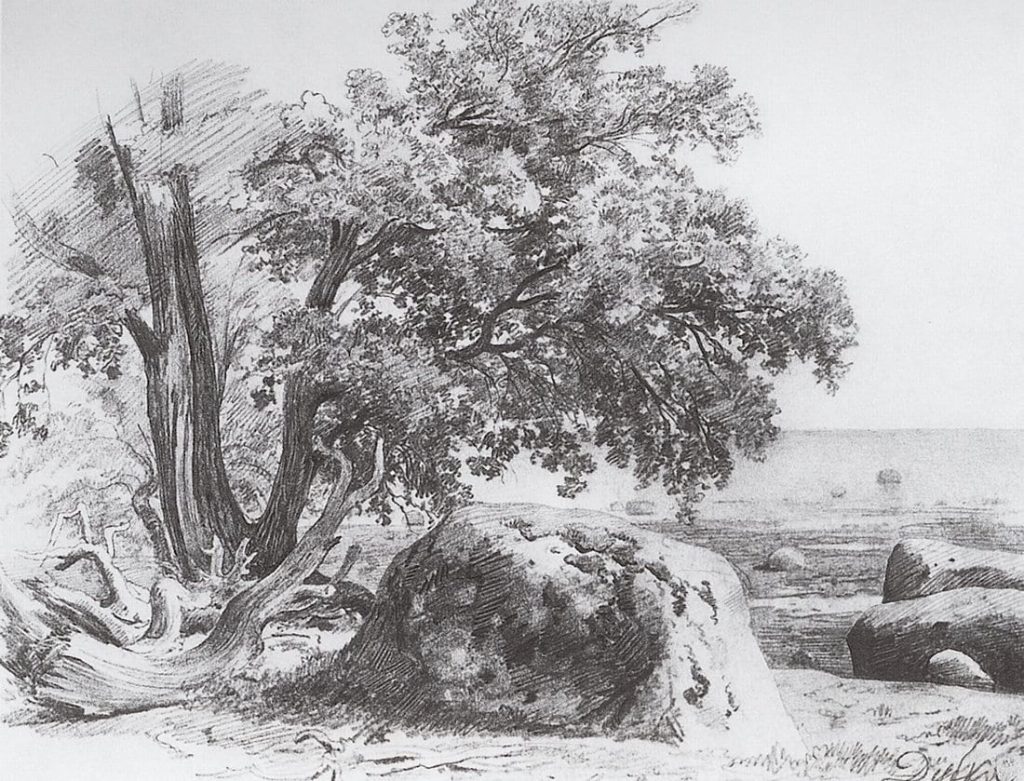
- Reaction against academicism: in the late nineteenth century, many artists began to oppose academic traditions, seeking new forms and styles such as Impressionism and Post-Impressionism.
- Gradual change: in the twentieth century, academic drawing became less rigorous and varied. Modern art schools and academies usually give students more freedom to choose styles and techniques.
The history of academic drawing reflects changes in artistic practice, views of art, and teaching methods over the centuries. Academic drawing can now be seen as one of many approaches to fine art, and artists have the opportunity to experiment with different styles and techniques.
Basic concepts in academic drawing
- Composition – the arrangement of elements on canvas or paper. The artist must determine what elements will be included in the work and how they will be arranged. The composition can be symmetrical or asymmetrical, you also need to make sure it is balanced.
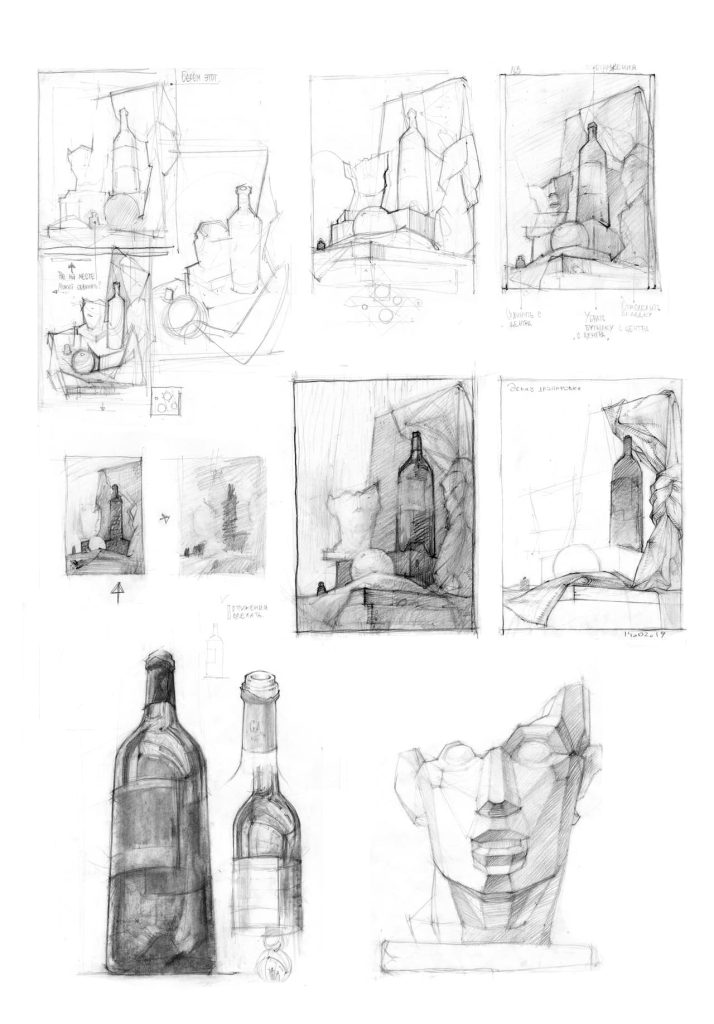
- Proportions. The artist must determine which elements will be larger and which will be smaller, and how they will relate to each other.
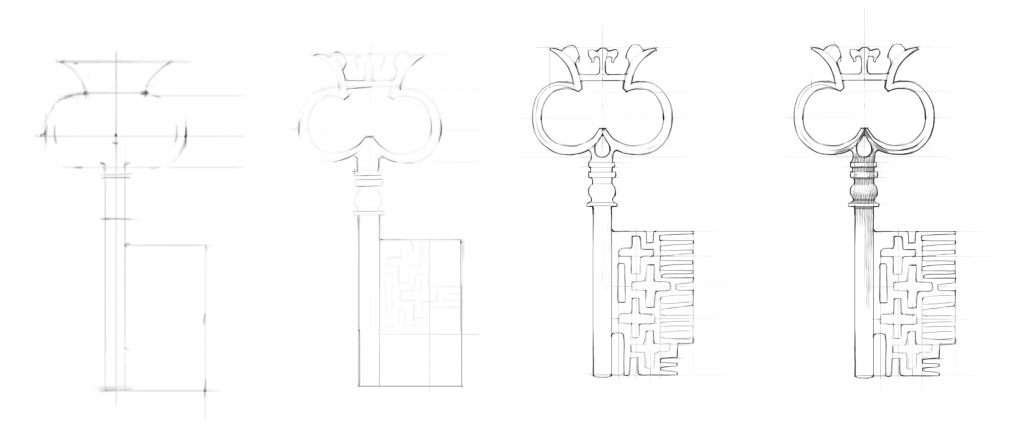
The proportions can be realistic or slightly distorted to create more artistic expression. To form a sense of proportion, the artist must work a lot with nature: start from the simplest objects (geometric figures of plaster, still life with fruits, vegetables, etc.) and finish drawing the human figure, making many sketches, noting important proportions and details that are difficult to learn only from textbooks on plastic anatomy.
- Perspective – the ability to depict three-dimensional objects on a plane. The artist must determine which elements will be in the foreground and which will be in the background, and how they will relate to each other. Perspective can be linear or aerial.
For linear perspective, construction methods with one, two or three vanishing points are used. For aerial perspective, various effects are used to make the foreground stand out in contrast, clarity, and detail in relation to the distant foreground.
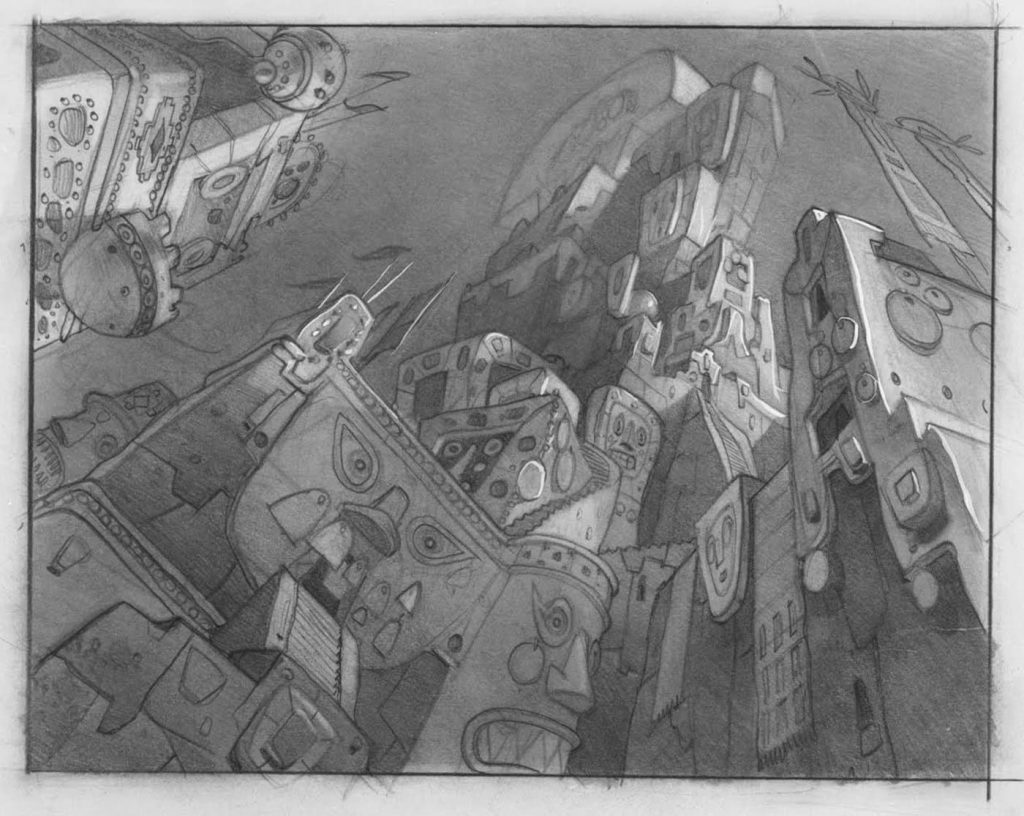
- Light shading – using light and shadow to create volume and depth in a drawing. The artist must determine where the light is coming from and how it falls on the elements in the drawing. You can use hatching or blending to create light shading, depending on whether we want to convey a more realistic or stylized graphic style effect.
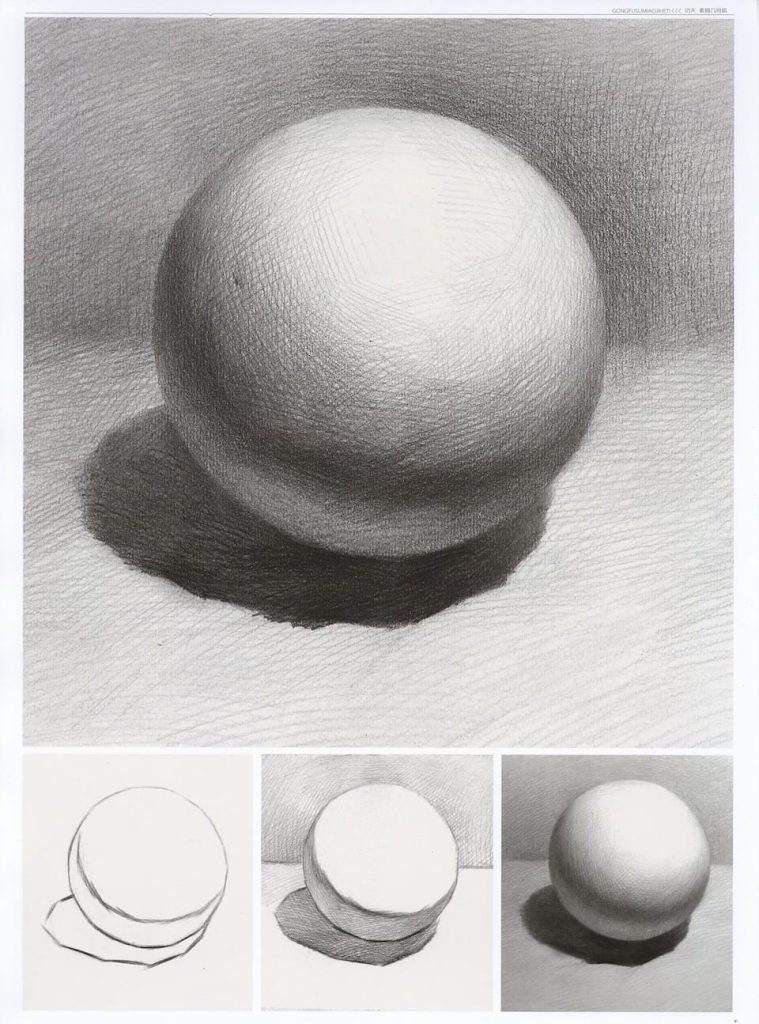
- Stroke and texture. To make the drawing more interesting, there should be different textures in it, they should not draw too much attention to themselves, but they saturate and enrich the drawing well. You can use different strokes, lines in different directions, dots, and so on.
Stroke is used to create shadows, add volume to shapes, or emphasize the surface texture of objects. The artist may use different hatching techniques to achieve a certain visual effect, mimicking the texture of the subject.
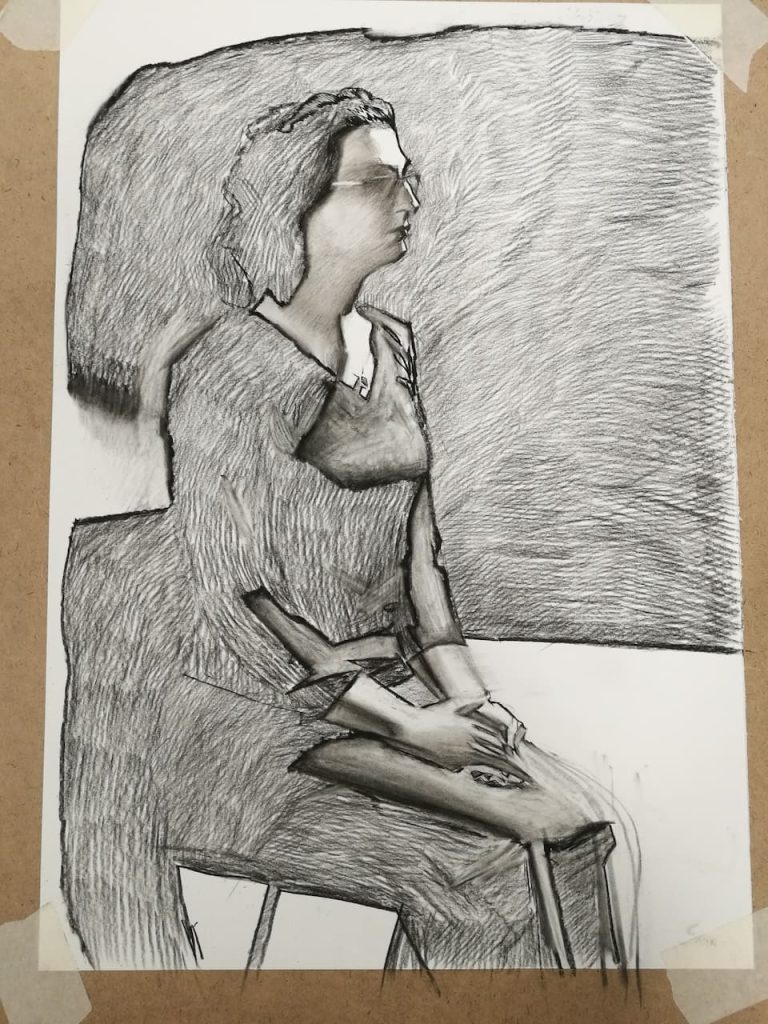
- Line. Lines are used to create contours and details of objects. They can be crisp or soft, straight or curved, and their variety allows them to convey different effects and moods in a drawing.
These are just a few of the concepts that are used in academic drawing. They help the artist create quality works that look realistic and have depth and dimension.
Academic pencil drawing
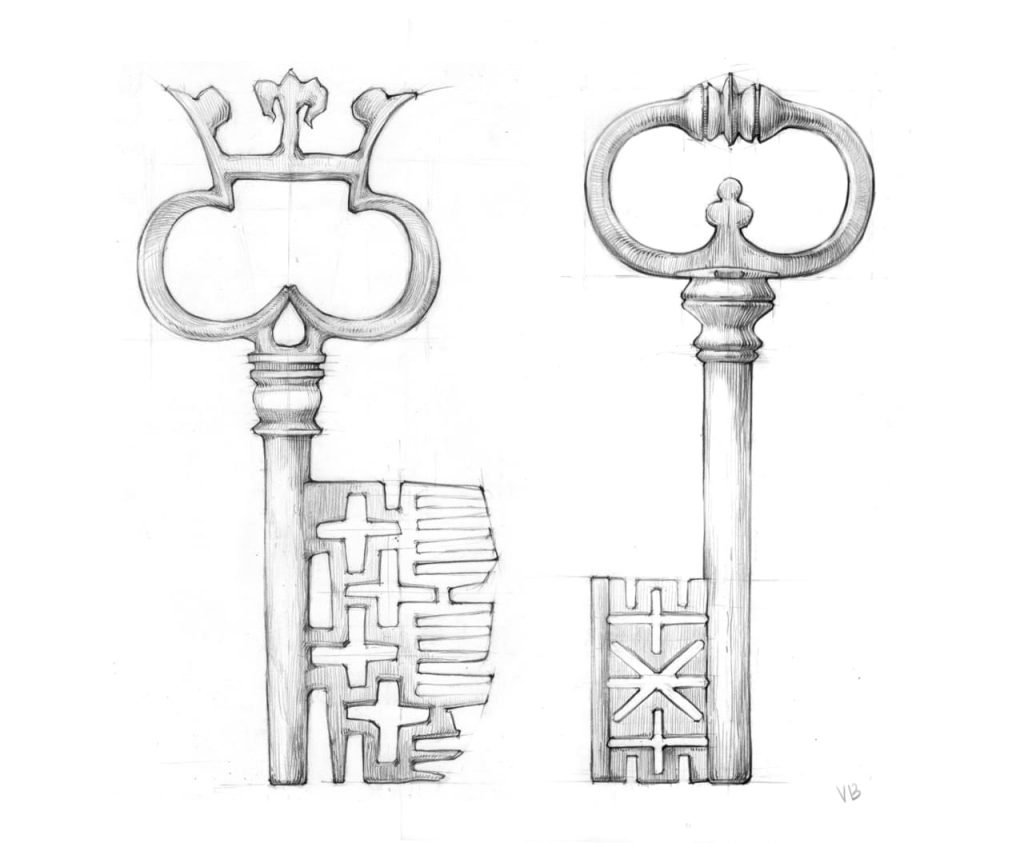
Pencil is one of the most popular tools used in academic drawing. It allows you to create realistic images by rendering the volume and texture of the subject using light shading.
The principle of drawing with a pencil is to use different shading techniques with the help of which you get different effects of light shading and texture. For example, you can use a cross-hatching technique to create shadows, or a blending technique to create softer transitions between light and dark areas. Also pencil is very well suited for linear-constructive drawing, in which we build the structure of the volume, and then already model the volume of light and shadow gradients.
To sketch from life, you also need a pencil, only it should be soft. This pencil makes it very easy to create a contrasting bold line by controlling the degree of pressure, increasing thickness and contrast in the right places.
Mistakes that are made while working on a drawing
Mistakes that are made while working on a drawing, can be associated with the wrong choice of scale, proportions, perspective, light shading and texture, errors in human anatomy. It may be that the human artist has done too much detail, working through each section of their drawing, thus overloading their work with information.
Using the wrong hardness of pencil can make the drawing look faded or too dark. Drawing from photos is also not a good option when you are learning to draw. The fact is that photographs distort the silhouettes of objects and simplify light and shadow relationships – this can make the drawing look flat and the light unreliable, and the drawing will appear crooked and unrealistic.
These are some of the mistakes that can occur when working on an academic drawing. However, with practice and training, these mistakes can be corrected and the artist will produce quality work.
The study of academic drawing usually involves a certain sequence of stages, starting with mastering the basic skills and gradually moving on to more complex aspects. If you are just beginning to draw, you can start by learning the basic elements used in academic drawing – line, stroke, perspective, light and shadow modeling of form.
Now let’s get to practice: a video tutorial on drawing a flower

